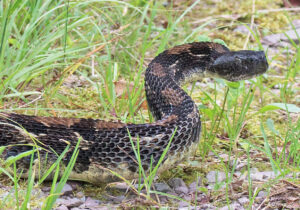Spent a beautiful day looking for butterflies in Garrett County, MD and then my neighborhood here in Berkeley County, WV. A good variety was on the wing. Temps were in the mid 70’s in the mountains and mid 80’s here at home. In the upper part of “The Woods” subdivision there are now many Butterfly Bushes that have sprung up due to seeds being washed down the hill into the drainage gullies. These seeds originated from a house at the top of the hill that has several mature Butterfly Bushes. Combine that with this area not being developed yet and you have empty lots full of mixed grasses that include Bluestem. The reason I bring up Bluestem is that it is one of the hosts for Leonard’s Skipper which was also found. While searching through the lower collection of bushes Barry Marts located a Clouded Skipper at the house at the top of the hill. This was a new WV lep for me! Another southern irruptive species for the season. Can an Ocola Skipper be far behind? I love seeing the ventral view with the dark PM band that gets wider towards the top of the hind wing. Reminds me of a tornado vortex. Several other grass skippers were found, most being worn with a few exceptions. Sachem was the most plentiful followed by Crossline (6), Zabulon (3), Peck’s (2), Tawny-edged (1) and the before mentioned Leonard’s (1) and Clouded (1).

In Garrett County we only spent a couple of hours but it was enough time to find (2) fresh Gray Comma’s. Eastern Comma was plentiful (12) following by Question Mark (2). This was most certainly a great day to be in the field. It not often you’ll be able to see a Leonard’s Skipper, Clouded Skipper and Gray Comma on the same day in our region.

April 2025 M T W T F S S 1 2 3 4 5 6 7 8 9 10 11 12 13 14 15 16 17 18 19 20 21 22 23 24 25 26 27 28 29 30 -
Recent Posts
Recent Comments
- Another lifer after 6 1/2 years… | West Virginia Butterflies on Olympic National Park
- admin on A lifer after all these years…
- Bob Summers on A lifer after all these years…
- Rick Cheicante on A lifer after all these years…
- admin on Lower Rio Grande Valley – 2018
Archives
Categories
- Blues (69)
- Brush-footed (106)
- Butterfly ID (16)
- Duskywings (50)
- Gossamer-winged (62)
- Metalmarks (14)
- Milkweed Butterflies (42)
- Remote Trip (81)
- Satyrs (36)
- Skippers (110)
- Swallowtails (69)
- Uncategorized (21)
- Whites and Sulphurs (84)
- WV Trip (30)
Blogroll
Reference Sites

















